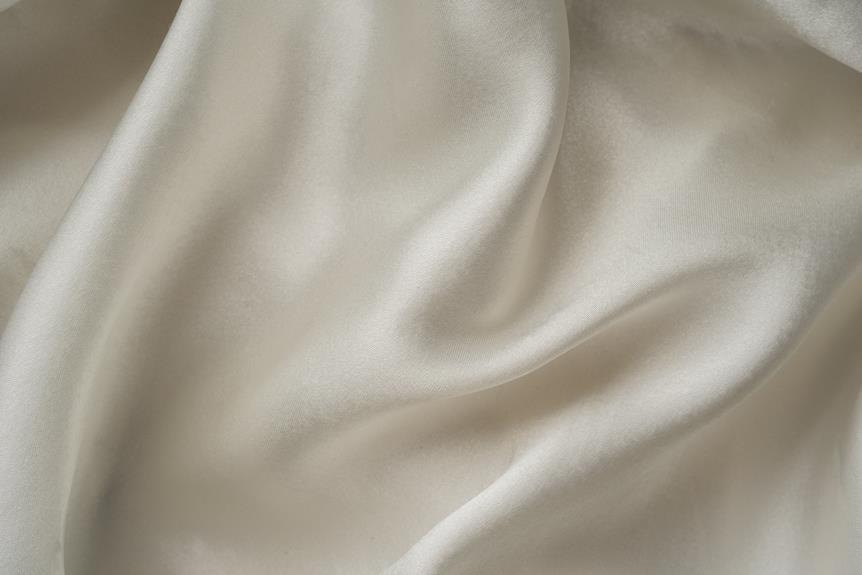Curiosity may have killed the cat, but it won't leave you hanging when it comes to fabric knowledge. In 'Does Silk Stretch? Your Fabric FAQs Answered,' you'll delve into the ins and outs of silk's stretchability.
You'll learn about the factors influencing its elasticity, how to test its stretch, and even some pro tips for maintaining its resilience.
Get ready to master the art of understanding fabric properties and comparing silk's stretch with other materials.
This guide is your ticket to demystifying the stretchy world of silk and taking your fabric expertise to the next level.
Key Takeaways
- Silk has limited natural stretch and can stretch slightly with the bias.
- The stretch of silk can vary depending on the weave and weight.
- Silk is not as stretchy as elastic fabrics.
- Factors such as weave type, weight, cut, blend with other fibers, and fabric preparation can affect silk's stretch.
Understanding Silk Fabric Properties
If you're wondering about silk fabric properties, understanding its unique characteristics is essential for making informed decisions about your fabric choices.
Silk is renowned for its luxurious feel, natural sheen, and remarkable strength. Its properties make it a highly sought-after fabric for a range of products, from clothing to home furnishings.
One of the most notable silk properties is its hypoallergenic nature, making it an excellent choice for those with sensitive skin. Additionally, silk fabric characteristics include its ability to regulate temperature, keeping you cool in warm weather and retaining heat in colder temperatures. This makes it an ideal fabric for all seasons.
Silk is also highly absorbent, wicking moisture away from the body, and is known for its durability and resistance to wrinkling.
Understanding these silk properties and fabric characteristics empowers you to make informed choices when selecting textiles for various applications. Whether it's for fashion, bedding, or other uses, knowing the unique properties of silk can help you appreciate its value and make the most of its exceptional characteristics.
Exploring Fabric Stretch and Recovery
Silk fabric exhibits a slight amount of stretch and excellent recovery, making it a versatile and comfortable material for various clothing and textile applications.
When considering fabric stretch, it's essential to understand its elasticity and recovery properties. Fabric stretch refers to the material's ability to elongate when force is applied, while recovery pertains to its capacity to return to its original shape after being stretched.
The elasticity of silk allows it to stretch moderately, providing comfort and ease of movement for the wearer. However, what truly sets silk apart is its exceptional recovery. After stretching, silk fabric quickly bounces back to its original form, maintaining its shape and structure over time.
This unique combination of stretch and recovery makes silk an ideal choice for garments that require both comfort and durability. Understanding these fabric properties allows you to make informed decisions when selecting materials for your sewing projects, ensuring that your creations not only look stunning but also provide the desired level of comfort and wearability.
Factors Affecting Fabric Stretchability
The factors affecting fabric stretchability play a crucial role in determining the performance and versatility of different textiles. Understanding these factors is essential for mastering the behavior of fabrics.
Material composition is a primary factor influencing fabric stretchability. Fabrics made from natural fibers like cotton or silk tend to have less stretch compared to those made from synthetic materials such as spandex or elastane.
The arrangement of fibers within the fabric also contributes to its stretchability. Knit fabrics, for example, have more stretch than woven fabrics due to their interlocking loops.
Additionally, environmental conditions can impact fabric stretch. Humidity can cause fabrics to stretch more than usual, while extreme temperatures can alter a fabric's elasticity.
The way a fabric is woven or knitted also affects its stretchability. For instance, the direction of the weave or knit can determine how much a fabric stretches in a particular direction.
Testing Silk for Stretch and Elasticity
Considering the factors that affect fabric stretchability, you may want to test silk for its stretch and elasticity to understand how it compares to other materials.
When testing silk for stretch, start by gently pulling the fabric from both ends. Unlike synthetic materials, silk has limited stretch and should only give slightly under tension.
Next, conduct a fabric elasticity analysis by stretching the silk in both directions to observe how it responds. Silk should have some give, but it won't stretch as much as materials like spandex or elastane.
Additionally, you can perform a simple wrinkle test by crumpling the fabric in your hand and then releasing it to see how well it springs back. This can provide insight into the resilience and elasticity of the silk.
Silk Care Tips to Maintain Stretch
To maintain the stretch and elasticity of your silk fabrics, it's important to follow some key care tips.
Preventing shrinkage and preserving the natural properties of silk can be achieved through proper washing and storage methods.
Preventing Silk Shrinkage
To prevent silk shrinkage, regularly hand wash your silk garments in cold water and avoid wringing or twisting them to maintain their stretch.
Here are some essential tips for preventing shrinkage and maintaining the stretch of your silk fabric:
- Use a gentle detergent specifically designed for delicate fabrics.
- Avoid using bleach or harsh chemicals that can damage the silk fibers.
- Air dry your silk garments by laying them flat on a clean towel to preserve their shape.
- Store silk items in a cool, dry place away from direct sunlight to prevent any potential shrinkage or damage.
Preserving Silk's Elasticity
Preserve the elasticity of your silk fabric by gently stretching it while it's damp to maintain its natural drape and flexibility.
To retain silk's stretch, handle it with care. Avoid wringing or twisting the fabric, as this can damage its elasticity. Instead, gently press out excess water and then lay the silk flat on a clean, dry towel. Roll the fabric in the towel to remove any remaining moisture, being careful not to pull or tug at the silk.
When storing silk garments, ensure they aren't tightly packed, as this can lead to loss of elasticity.
Comparing Silk Stretch With Other Fabrics
You can compare silk stretch with other fabrics by examining their elasticity and durability. When considering which fabric to use for your next project, it's important to understand how silk's stretchability compares to other popular fabrics. Here's a quick rundown to help you make an informed decision:
- Elasticity: Silk has a natural elasticity that allows it to stretch comfortably without losing its shape, making it an excellent choice for garments that require movement and flexibility.
- Durability: While silk is known for its luxurious feel, it's also surprisingly durable, especially when compared to delicate fabrics like chiffon or lace.
- Versatility: Silk's stretchability makes it versatile for various applications, from elegant evening gowns to everyday wear like blouses and scarves.
- Comparison with Other Fabrics: When comparing silk's elasticity with other fabrics, consider factors such as spandex for high stretchability, cotton for breathability, and polyester for wrinkle resistance.
Understanding how silk's stretchability stacks up against other fabrics will help you select the perfect material for your next sewing or fashion project.
Frequently Asked Questions
Can Silk Be Stretched to Fit Different Body Shapes and Sizes?
Yes, silk can stretch to fit different body shapes and sizes. Its natural elasticity allows for body conformity, making it a versatile and comfortable fabric. Whether you're petite or curvy, silk adapts to your unique form.
How Does Humidity and Temperature Affect the Stretch of Silk Fabric?
In cold weather, silk fabric tends to stretch less due to the lower temperatures causing the fibers to contract. The effect of moisture can also impact the stretch of silk, with high humidity potentially increasing its elasticity.
Can Silk Lose Its Stretch Over Time With Regular Wear and Washing?
With regular wear and washing, silk can lose its stretch over time. To maintain silk elasticity, handle it with care by hand washing in cold water and avoiding wringing. Air dry to preserve its natural stretch.
Are There Specific Sewing Techniques That Can Help Maintain the Stretch of Silk Fabric?
To maintain the stretch of silk fabric, consider using sewing techniques like adding elastic or reinforcing seams. Proper fabric care and garment construction can also help preserve elasticity. Regularly practicing these methods will ensure long-lasting stretch in your silk pieces.
Does the Type of Silk (Such as Charmeuse or Crepe) Affect Its Stretchability?
When considering silk stretchability factors, the type of silk, such as charmeuse vs. crepe, plays a significant role. Charmeuse silk tends to have more stretch compared to crepe silk, making it essential to consider the fabric type for your projects.
- Does Chiffon Fabric Stink - July 15, 2025
- Does Chiffon Fabric Affect the Economy - July 15, 2025
- Does Cotton Fabric Have a Nap - July 15, 2025






